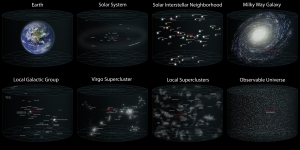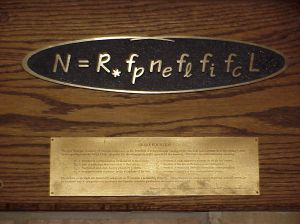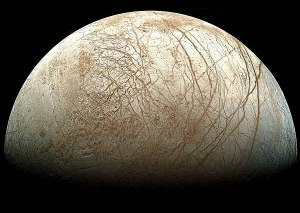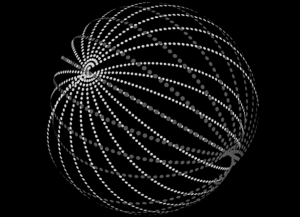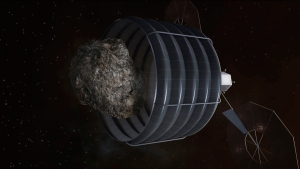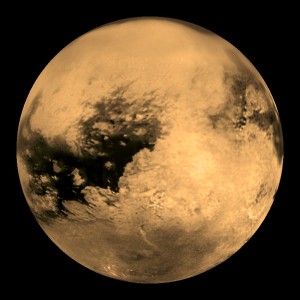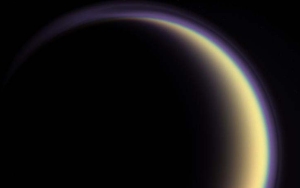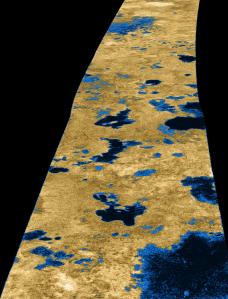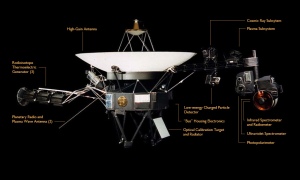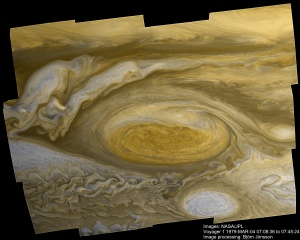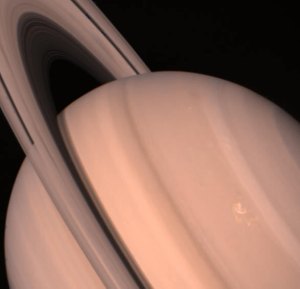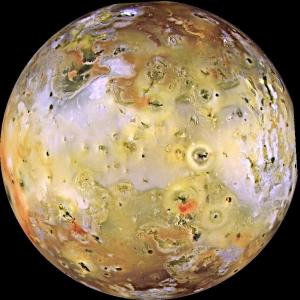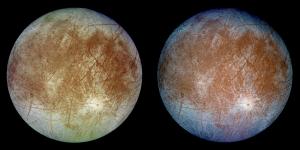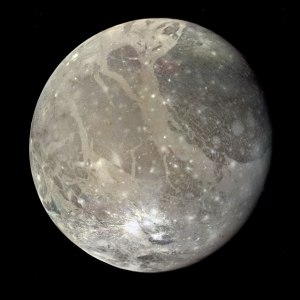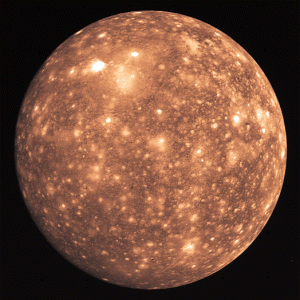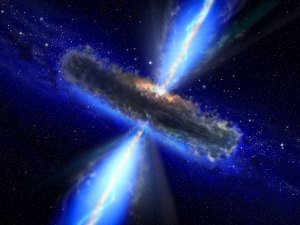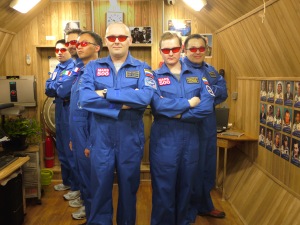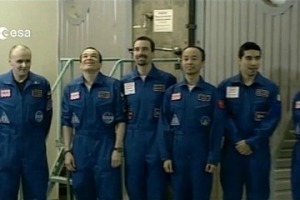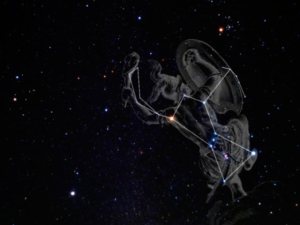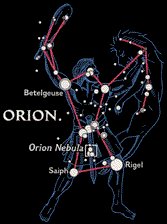Or, more accurately, the end of a semester. I’ve had a lot of fun blogging for this class, and I’ve learned a lot about that vast expanse above our heads known as the cosmos. One of the most important things I’ve learned, I think, is the vastness of space. Even in our solar system, planets and moons can be millions of kilometers apart from one another. These are huge distances, that, with my limited human mind, are extremely difficult to grasp. But, I always have to keep in mind that the astronomical objects I talk about so off-handedly are separated by ridiculous amounts of space. Another thing that has left a deep impression on me is the amount of stuff that is out there. Now when I look up into the night sky, I see not only the stars, but I imagine the galaxies whirling around, just as our own galaxy is whirling about, just as the planets in our solar system orbit about the Sun, and just as Earth rotates about its axis. All this intricate motion and universal complexity fascinates me, and I find it a transcendental experience.
Universal Scale (courtesy Wikipedia)
I am also really interested in the search for extraterrestrial life, because our universe seems so empty, but can it really be so? Naturally, then, I was really intrigued by the Drake equation that we learned about in class.
Original Drake Equation (courtesy SETI League)
I had a great time hypothesizing about the number of planets that can support life, what percentage of that life will become intelligent, and so forth. In the future, I’ll definitely be most interested in what new developments in the search for interstellar life come up, especially since the discovery of extremophiles on Earth means that life on other planets is now a real possibility. On a related note, I’m really looking forward to the upcoming mission to (ok, flyby of ) Europa maybe starting around 2021. Europa’s subsurface ocean is really cool (especially since it’s formed by tidal heating from Jupiter) and since water is fundamental to life on Earth, who knows, maybe we’ll someday find life on that moon too.
Europa (courtesy NASA)
The more we discover about our universe, the more surprised we are. For example, I found this article about “stellar extremophiles“, or stars that form in places where we thought they shouldn’t, for example, in places where we thought gas density would be too low for the gas to collapse and begin nuclear fusion (a.k.a. star birth). Researchers using NASA’s GALEX (Galaxy Evolution Explorer) space telescope have found stars forming outside the gassy disks of spiral galaxies, and various other places. Here’s a video talking about the discovery. It’s cool that this could be telling us that there could be ways to make stars in extreme environments, just as life seems to find a way to survive on Earth, no matter the conditions. In the future, I’ll be looking out for news talking about the exploration of the extremes of the cosmos, because that’s just the kind of thing that ignites my imagination most when I think of that inky black space above our heads.
The Kardashev Scale
As we persevere in our search for other intelligent life out there in the far reaches of space, we should also remember that, if they exist, we have no idea what they would look like, or how powerful they might be in comparison to us, or how they would respond to us contacting them. This idea of how much “power” an alien race could have is an engaging one, and luckily, there happens to be a sweet scale that can help us to measure it! It’s called the Kardashev Scale, and it was first proposed in 1963 by Russian cosmologist Nikolai S. Kardashev, who was actually influenced by a project Launched by Frank Drake (of the Drake equation) called Project Ozma. Project Ozma’s goal was an attempt to locate extraterrestrial intelligences (ETIs) by scanning the sky for radio emissons. Inspired by the project, Kardashev began to wonder if a large number of alien civilizations might be millions of years ahead of us, and if so, what their radio signatures might be like. This caused him in 1963 to write a paper called “Transmission of Information by Extraterrestrial Civilizations”, in which he proposed a simple numbering system, from 1 to 3, that could be used to classify hypothetical alien civilizations based on the amount of energy they had at their disposal, specifically the power available to them for radio transmissions. These days, the scale has been modified by all kinds of scientists, astrobiologists and cosmologists alike, to simply describe the amount of energy available to an ETI for any purpose, and is often used to speculate about the kinds of technologies that advanced civilizations may possess. Here are the Kardashev Types:
Us, as estimated by Carl Sagan, although we are getting close to Type 1.)
Type 1
A Type 1 civilization would be close to Earth in terms of technological level, with an energy consumption of a bout 4 x 10^12 Watts. This civilization has harnessed all the power available to it on its home planet (i.e. all the solar energy, thermal, hydro, wind, etc.), but has not yet begun to exploit all of the solar’s systems resources. Defined even more radically, Type 1 status would only “truly be achieved once the entire planet is physically reconfigured to maximize its energy producing potential.” For example, the entire mass of a planet could be remade into a form of a massive solar array to feed the civilization’s power-hungry machines.
Type 2
In order to advance to Type 2, a planet would need to make a jump in energy consumption that will be equal to the output of the Sun per second. In order to reach this level, an ETI would need to capture the entire energy output of its parent star, with the best way to achieve this being the building of a Dyson Sphere. The Dyson Sphere was hypothesized by Freeman Dyson in 1959; it’s a hypothetical megastructure that would envelope a star at a distance of 1 AU and cover an incredibly large area of 2.72 x 1017 km2 (about 600 million times the surface area of the Earth). The sun’s energy output of around 4 x 1026 Watts would then be available to utilize for work. With all this available energy, a Type 2 civilization would be able to power its supercomputers and send out interstellar colonization waves.
Dyson Swarm, a type of Dyson sphere (courtesy, The Atlantic)
Type 3
Going one order of magnitude further, a Type 3 civilization would possess an amount of energy on the scale of its own galaxy, somewhere between 10^36 and 10^37 Watts. The entire galaxy of a Type 3 civilization would be colonized, with every scrap of matter exploited for energy. Consequently, to outside civilizations, a Type 3 one would appear completely invisible, with only a small amount of heat leakage registering in the far infrared (10 microns in length). Essentially, it would look like a hole in a galaxy, or an inexplicably large swath of open space. When looking for Type 3 civilizations, we might even do better to look for Type 2 civilizations on the brink of becoming Type 3, because their colonization waves would look like a giant bubble spreading outward from the parent star.
Type 4?
Hypothetically, ETI(s) that have harnessed the power of a galactic supercluster
Type 5?
Although highly unlikely, a Type 5 civilization would have the power of the entire universe at its disposal.
Problems With the Scale
Of course, what would any good hypothetical scale be without its problems? First, there is the Fermi Paradox, which is “the apparent contradiction between high estimates of the probability of the existence of extraterrestrial civilization and humanity’s lack of contact with, or evidence for, such civilizations.” We have no empirical evidence for the existence of Type 2 or 3 civilizations in our galaxy or galactic neighborhood, we do not see vast swaths of neighboring galaxies “disappear” from the visible spectrum (as predicted by the Scale), and we haven’t found any Dyson spheres yet either. Additionally, the Scale assumes that advanced civilizations have an insatiable appetite for energy, but what if it never really wanted to expand beyond a Type 1 or 2 level? Or what if it wanted to honor some kind of “Prime Directive” (woot woot Star Trek shout-out), or didn’t want to become some kind of Galactic Empire (woot woot Star Wars shout-out)? All these things would preclude a civilization from maybe even going Type 3. But, in the end, all this is conjecture, since we haven’t found anything yet. I say, let’s just keep looking and hope anything we find doesn’t end up wanting to “kill all humans” (woot woot Futurama shout-out).
Also, here’s a video of theoretical physicist Michio Kaku explaining the Types and why we’re still at Type 0 (but straining for Type 1!).
It looks like we’ll be bringing an asteroid home sometime soon. NASA wants to identify an asteroid in deep space, figure out a way to capture it, and bring it into our own planetary region, ultimately setting it in orbit around our moon, all by the year 2025. This proposal was included as a part of the NASA budget rollout for 2014, and an initial $104 million for the project is being provided by President Obama’s broader federal budget. NASA’s plan for the asteroid is to first capture it, then surround it with a large, flexible covering that will be towed by a space craft with large solar arrays.
Although the NASA project is similar to an idea proposed by scientists at the Keck Institute for Space Studies at CalTech, it will cost less than the projected Keck price tag of $2.6 billion, because NASA will look for their target asteroid much closer to earth, and because they will already be spending millions on related rocket technology.
Here’s a video from NASA describing the project.
Some of the goals articulated by the project are: learning how to identify asteroids heading toward us and to change their course, finding destinations where astronauts can go as they try to learn how to make the longer trip to Mars, and providing opportunities for space investors. Because asteroids are among the oldest objects in our solar system, bringing one into our neighborhood would give scientists an unprecedented opportunity to see what things were like at the formation of our solar system. It will also help astronauts practice for the projected mission to Mars further in the future. Another reason for the increased interest was the meteorite explosion above Chelyabinsk, Russia back in February, which has sparked conversation about “planetary defense”. Finally, several commercial space companies have expressed interest in mining the asteroid and having a potential space mining site so close would spur those company’s development.
At the very least, we can finally dispel asteroid misconceptions passed on to us by films like this, and this. Also, this. Terrible, I know.
Titan, Saturn’s largest moon (and second largest in the solar system), is a really cool world. Like Earth, it has a thick atmosphere, making it the only moon in our solar system to have one. Also, like Earth, Titan’s atmosphere is mostly composed of nitrogen, and has a presence of organic molecules that contain carbon and hydrogen. This has led many scientists to speculate that current conditions on Titan are like those during the early years of Earth. One major difference, however, is that because Titan is so cold,-290 F or -179 C, water is frozen as solid as a rock, but methane and ethane can be found in liquid form. In fact, similar to Earth’s water cycle, Titan has the phenomenon of a hydrocarbon cycle, in which liquid methane and ethane fall to the surface. In 2005, the Huygens probe was released by the Cassini spacecraft down to Titan’s surface, and pictures taken during the descent show that Titan’s polar region even has lakes and rivers filled with liquid methane.
What’s great about Titan is that it’s still making headlines. One new discovery has to do with the moon’s atmosphere. Back in 2009, Cassini spotted a glow emanating from Titan’s atmosphere. The emission comes from a mysterious gas and is strongest at an infrared wavelength of 3.28 micrometers, near one where emissions from methane are also very strong, one reason why these mystery emissions were previously obscured. The glow only appears on the moon’s daytime side, at altitudes between 600 and 1250 km, with the largest intensity occurring around 950 km. Normally, this light, known as airglow, is generated when atmospheric molecules are excited by sunlight or electrically charged particles. Therefore, scientists expected to see a glow in the high atmosphere because there, charged particles from the Sun and Saturn’s magnetic field strip away electrons from molecules in Titan’s atmosphere. The deeper glow (below 700 km), however, has puzzled researchers, because it originates too far down to be caused by the excitation of atmospheric molecules by charged particles. Perhaps the glow is produced by deep-penetrating cosmic rays or by light emitted by a chemical reaction deep in Titan’s atmosphere. Unfortunately, we still don’t know the glow’s cause, nor the chemical composition of the gas, for sure.
The second bit of news regarding Titan concerns its methane lakes. Apparently, we probably wouldn’t want to sail the Titanic through those waters either, because there may be chunks of hydrocarbon ice floating in them. Scientists first believed that methane ice on these seas would not be possible, as solid methane is denser than the liquid form. However, after a model investigating how Titan’s seas interact with its nitrogen-rich atmosphere (which creates pockets of varying composition and temperature) was created, scientists determined that hydrocarbon ice should indeed float in the moon’s seas, so long as the temperature is just below methane’s freezing point (-297 degrees F or -183 degrees C) and the ice is at least 5 percent “air”. That ice may only last a short time, however, as even a small drop in temperature would cause the ice to sink. The research team will be able to test out their model soon, as Titan’s northern spring is underway, warming up the lakes and seas there and allowing ice to rise to the surface. This in turn will create a surface that appears “brighter”, or more reflective, to Cassini and as the temperature increases further, the ice will melt, leaving an entirely liquid surface that will appear “darker”, or less reflective. As one researcher put it, the discovery that ice could form is important because “…the formation of floating hydrocarbon ice will provide an opportunity for interesting chemistry along the boundary between liquid and solid, a boundary that may have been important in the origin of terrestrial life.”
Hopefully, we’ll make even more discoveries about this fascinating world in the years to come, and hey, who knows, maybe one day we’ll even get to swim in those methane lakes ourselves.
So, has humanity become Earth’s first interstellar species? It all depends on whether the Voyager 1 spacecraft has left our solar system or not.
Voyager
First, some history. The Voyager program actually consisted of two space probes, Voyager 1 and 2, launched September 5, 1977 and August 20, 1977, respectively. The probes were launched in 1977 to take advantage of a once-every-177 year alignment of worlds in the outer solar system which would allow them to swing from planet to planet with minimal fuel. Voyager 1 itself made it out to the Jupiterian and Saturnian systems, providing up close photographs of things like Jupiter’s Great Red Spot, the Galilean moons, Saturn’s rings, and Titan’s (Saturn’s major moon) atmosphere. After last close fly-by of Titan, Voyager was directed on a course away from the Sun, to explore where the solar system officially ends. Voyager 1 is now the most distant man-made object from Earth, approximately 18 billion kilometers away, traveling at a speed of 17.26 km/s. Even though its original mission is long over, it has continued to send data back to scientists on Earth, and its nuclear power source is in fact estimated to last until 2025, meaning we’ll still be hearing from this intrepid spacefarer for years to come.
The current Voyager controversy, however, is whether or not it has actually left the solar system. False alarms have been raised before, the most recent case being by NASA last October, so the debate isn’t new. The answer, though, comes down mostly to semantics. Voyager’s sensors have detected a drop in radiation and an increase in cosmic rays. This is an indicator that it may have passed outside our solar system, because the area outside the solar system would also be outside the Sun’s heliosphere (the Sun’s protective magnetic bubble), and there would be an increase in the cosmic rays that are normally absorbed the the magnetic sphere. However, until a dramatic change in magnetic field intensity is detected, NASA scientists believe the probe is in a transition zone within the outer part of the heliosphere. Additionally, the Sun’s gravitational reach is distant, and the Oort cloud of comets 7.5 trillion km from the Sun should still be gravitationally bound to the star. If that is considered the real edge of the solar system, Voyager still has a long way to go.
Here’s a video by NASA describing Voyager’s final journey.
To me, moons are fascinating. Many planets in our solar system have them, with the majority belonging to the gas giants in the outer solar system. For me, the most interesting of all the moons is not Earth’s, but rather the Galilean ones, so named because Galileo Galilei was the first to discover them orbiting around Jupiter with his new high-powered telescopes. We now know that Jupiter’s gigantic gravity field has captured many moons, actually about 60, but the Galilean ones are the four most important and interesting: Io, Europa, Ganymede, Callisto. These are their stories.
Io
Io is the most geologically active world in our solar system, with over 400 active volcanoes. In fact, every one of the dots in the picture above is a volcano. Because of this rampant volcanism, Io’s surface is also one of the youngest looking in the solar system, since almost all of its impact craters have been filled in by lava. Surprisingly enough, the cause of all this constant activity is actually Jupiter. Io orbits Jupiter in synchronous rotation, and the force required to keep that rotation causes tidal bulges on Io. This constant change in size and orientation causes friction that creates the internal heat required for volcanic eruptions. Finally, even with all that volcanic activity causing outgassing, Io still only has an extremely thin atmosphere, made up mostly of sulfur dioxide. Most expelled gases are nabbed by Jupiter’s gravity and put into orbit in the Io torus, which is a doughnut-shaped ring of gas surrounding Jupiter.
Europa
Europa shares many characteristics with Io. Just like Io, it has a metallic core and rocky mantle. Also like Io, Europa has no impact craters, meaning it is still tectonically active and that its surface may only be a few million years old. The differences between the two however, are great. Rather than volcanoes, Europa’s surface (and crust) is covered by a layer of ice approximately 100 km thick. What is most exciting about Europa, though, is that it is a prime candidate for the finding of extraterrestrial life. It is theorized that liquid water exists under a thin shell of ice, because tidal friction caused by Jupiter should provide enough heat to make sure the ocean remains liquid and also drive geological activity (tidal flexing is also what causes the cracks on Europa’s surface). Scientists hope that primitive life may exist then underwater, near hydrothermal vents, just as on Earth. One last interesting note about Europa is that its atmosphere, though tenuous, is composed mostly of oxygen, a gas important at least to life on Earth.
Ganymede
Ganymede is the largest moon in our solar system, at 5262 km across. It also has a geography similar to Europa’s, in that its surface is composed of water ice, and a saltwater ocean is thought to exist 200 km below its surface, sandwiched between layers of ice. Unlike Europa, however, its surface shows signs of age, along with visible craters on the surface, meaning it is no longer as geologically active as in the past. What’s also interesting is that a strong magnetic field (perhaps even a magnetosphere) has been detected around the moon, leading to speculation that it still contains a liquid iron core, heated by radioactive decay and tidal heating. Finally, Ganymede has a tenuous atmosphere, composed mostly of oxygen and ozone.
Callisto
Callisto is the second largest of the Galilean satellites, and has a geography similar to Ganymede’s (mostly rock and ice), but with even more cratering, indicatingan even cooler interior. Callisto is considered “boring” by some, since it seems to be a dead world, but it does still have some interesting features. First of all, it has a very thin atmosphere composed mostly of carbon dioxide. Second, it has an induced magnetic field, which may be evidence of a salty liquid ocean beneath its surface. Lastly, it has a 3000 km wide impact crater in the shape of a bulls-eye, named the Valhalla Basin, which was produced about 4 billion years ago. Upon impact, the foreign object exploded, heating the subsurface ice to above the melting point and producing shock waves in a ripple pattern away from the impact site, giving it its distinctive look. What’s cool too about Callisto is that it is considered the most suitable place for a base for future human exploration of the Jupiter system, since it is furthest from the intense radiation of Jupiter.
There you have it, the four Galilean moons. With such a diversity of worlds, I think it’s pretty clear why I find these moons to be so interesting. Sorry, Earth’s Moon, but in the end, you just can’t compete with these guys.
I’m fascinated by the end of the universe. It’s a pretty interesting mental exercise, theorizing about how everything might end (and us with it), especially since I definitely won’t be around to see any of those theories come to fruition. Of course, I have a favorite theory, that being the “Heat death of the universe”. It’s my favorite, because it combines two really cool things, the end of existence and entropy. The end of existence is, I think, pretty self-explanatory, but the term entropy may be unfamiliar to some.
Entropy is a concept in physics that is the measure of the amount of decay or disorganization in a system as the system moves continually from order to chaos. According to the Second Law of Thermodynamics, in general, the total entropy of any system will not decrease other than by increasing the entropy of some other system. Hence, in a system isolated from its environment, the entropy of that system will tend not to decrease. Since a finite universe is an isolated system, the Second Law of Thermodynamics states that its total entropy is constantly increasing.
Here’s a video explaining entropy in a British accent.
In our universe, then, as entropy increases, it spreads out heat. Just as a cold object next to a hot one will warm up due to heat transfer, warm things in our universe, i.e. every star, including our Sun, is radiating heat out into the colder universe. However, this won’t go on forever, as eventually, through both the burning of fuel and heat dispersion, the heat will have spread out so much that there won’t be cooler and warmer objects. This is the basis of the “heat death” theory. Everything will be the very same, extremely cold, temperature. At that point, the universe will have attained a “steady state” in which there will be no energy differences and no ability to extract work from the universe. Gravity itself plays a large role in entropy increase, because it causes matter to coalesce into stars, which in turn become black holes, where the entropy is proportional to the surface area of the black hole’s event horizon.
Artist’s rendition of a black hole
This is important because, if they are totally effective matter and energy traps, that makes them the likely termini of all entropy-increasing processes. Luckily for all of us, however, heat death is projected to take at least 10100 years (this being the decay time of a supermassive black hole of approximately 1 galaxy-mass).
On a cheerier note, the heat death model does have its detractors. The main argument against it is that, although entropy does increase in our model of our expanding universe, the maximum possible entropy that can exist is also increasing. This results in an ever-widening entropy gap that pushes the universe farther away from heat death. Ultimately, it is just difficult to make any accurate prediction of large-scale thermodynamics.
Of course, even if heat death won’t occur, there are still plenty of other ways for the universe to get us in the end…
So this piece of news is a bit old, but I think its worth talking about: we’re one step closer to intersolar travel! I’m not talking about a probe or rover, however. In this case I’m talking about things of a human nature. From 2007 – 2011, in a cooperative effort between the Moscow-based institute, the European Space Agency, and China’s space training center, an experiment called Mars500 was carried out in a mock spaceship in the Russian Academy of Sciences’ Institute of Biomedical Problems. In a series of three phases, the experiment was designed to study the psychological and physical effects of long-haul space flights on human, specifically to the Red Planet and back (but only the participants in the third phase stayed in the capsule for the full 520 days). In that last experiment, six men, three Russian, one Italian-Colombian, one French, and one Chinese, stepped into the mock-up and were not let out again until 18 months later. When the “spaceship” door was once again opened on November 4, 2011, all six men emerged, pale and thinner than before, but virtually unscathed.
In fact, results from the experiment showed that “there was no isolation within the isolation chamber“, and each member of the crew had at least a minimum amount of social contact. The researchers also found that no deadly microorganisms had grown in the “spaceship” during the experiment, but they did find evidence of the formation of “biofilms” on structural elements inside the spacecraft, and more importantly, on components in the life support system. This could present a risk for crews of real long-haul flights, as they may cause not only infections, but also lead to the malfunction of important instruments. One last finding regarded sleep deprivation in the astronauts. The mission changed the sleep patterns of some of the crew members and led to greater sedentariness, decreased alertness, and disturbed sleep quality.
Also, here’s a link to a video diary the ESA put together of those 500 days.
Unfortunately, any thought of a real long-haul flight is still far in the future, as our technology is still decades away from being able to protect astronauts from cancer-causing cosmic radiation, land them on a planet 54.6 million miles away, and bring them back home again. However, although this experiment highlighted some challenges that need to be addressed as we get ever closer to sending a crew of astronauts out on a long-haul trip, I’m still really excited by the results. At least from a human psychological level, I think the fact that six men of different nationalities could make it for the 520-day round trip without incident shows that with the right screening and training, it will definitely be possible to send manned international missions to explore the wonders of our own solar backyard.
Galileo Galilei
Galileo Galilei is important to astronomy for several reasons. Although he often receives credit for inventing the telescope, he did not actually do that. He did, however, greatly improve upon them, to such an extent that they could be used to peer far into space. His other great contributions were being the first to see craters on the Moon, discovering sunspots, tracking the phases of Venus, seeing the rings of Saturn (as well as the planet itself), viewing the four largest moons of Jupiter (now called the Galilean moons) and maybe even discovering Neptune 200 years before it was officially recorded. In addition to all that, he was also the first great advocate of the Copernican view of the solar system.
Concurrent Historical Events
Eighteen years after his birth, Galileo would have experienced the 1582 institution of the Gregorian calendar by Pope Gregory the XIII. This calendar is the one still used in the West today, and accepted in most other parts of the world. Another historical event that Galileo lived through, especially important for Americans, was the 1607 founding of Jamestown in Virginia. Jamestown was the first permanent English colony in the New World and would be the capital of the Colony of Virginia for 83 years, from 1616 until 1699. He also would have lived through most of the Thirty Years War, one of the bloodiest religious wars in world history. It was fought between Catholics and Protestants on mainland Europe and lasted from 1618 to 1648.
Concurrent Historical Figures
During Galileo’s time, William Shakespeare (26 Apr. 1564 [baptised] – 23 Apr. 1616) would have been writing and acting in plays. Shakespeare is, of course, one of the most influential English writers of all time, having written around 40 plays throughout his career and also having invented around 1700 of our now common English words. Another great historical figure who lived at the same time as Galileo was Cardinal Richelieu (9 Sept. 1585 – 4 Dec. 1642). While a cardinal, he was also a duke and a Minister in France. He oversaw many of the day-to-day aspects of governing France and was responsible for helping King Louis XIII consolidate monarchic power, thereby turning France into a strong, centralized state. Finally, Galileo would have been alive for Sir Francis Drake’s (1540 – 28 Jan. 1596) second circumnavigation of the globe (after Ferdinand Magellan), from 1577 to 1580. Besides being the first Englishman to travel all the way around the world, he was also something of a pirate, attacking Spanish ships on their way home from the New World, laden with gold and other treasures.
Reflection
After finishing this assignment, I was really impressed by the sheer amount of history there is. Even the 16th and 17th centuries themselves are jam-packed with world events. When I think of history, I tend to think of one event at a time, but that really isn’t an accurate way of thinking of it. So many things are happening at the same time all around the world, it boggles the mind. Researching all of the important figures who were around at the same time as Galileo also made me wonder how much he would have known of the events going on outside of Italy. There was no internet or even reliable post service at the time, so I would like to know how important information about the world was disseminated, especially from nation to nation. One last observation I have is that even though there was so much going on all around, the things that stand out most are the actions individuals took that they are still remembered for today. Galileo played a relatively small role in relation to other events happening around him, but his discoveries resound through the ages down to the present day. Even comparatively small actors can eventually have a large impact.
Constellations of the northern sky
Have you ever looked up into the night sky, gazed upon the stars, tried to imagine them within those famous constellations, and wondered, how the heck does that group of stars look like a man carrying a club and a shield/lion/pelt? That would be Orion, (also, The Hunter) who I found several different representations of:
Orion w/shield Orion w/lion Orion w/pelt
The Greeks even created a legend about Orion and another constellation, Scorpius. Perhaps the best explanation is that the Ancients had very active imaginations. In any case, every culture has their own representations of the images in the nighttime sky. So, why do we have the constellations we have today, which mostly come from Greek and Roman mythology? Well, in the Western world, the Greeks created comprehensive lists of constellations, with 48 already in the 2nd cent., however, these were all in the northern sky. The southern sky constellations were added only after Europeans began the Age of Exploration and were often faced with an unfamiliar sky. Some were even named after scientific inventions of the day, such as Fornax the Furnace, Antlia the Air Pump, Horologium the Pendulum Clock, and Microscopium the Microscope. Of course, we don’t have these constellations today, and that is due to the original borders of these constellations being a bit fuzzy. There were no fixed boundaries for them, as they were meant to be eye-visible stars, so the positions of constellations were getting difficult to discern. Finally, in the 1920s, the International Astronomical Union, made up mostly of Europeans influenced by Greek and Roman tradition, set the current constellations in the night sky. This is also why an astrology Zodiac doesn’t match the modern sky; the Sun travels through more than the 12 signs of the Zodiac in a given year. Another cool thing to note is the names of some of the constellations that didn’t make the cut: Globus Aerostaticus the hot-air balloon, Robur Carolinum the Oak of Charles, and Le Renne the Reindeer (plus those ones above based on inventions). Maybe it wasn’t just the Ancients with overactive imaginations after all.
Source:
